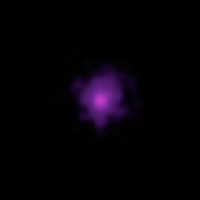
Click on the image for the full animationThe brightest pulsar detected to date is shown in this animation that flips back and forth between images captured by NASA's Nuclear Spectroscopic Telescope Array, or NuSTAR. A pulsar is a type of neutron star, the leftover core of a star that exploded in a supernova. These dead stars send out rotating beams of X-rays that sweep past Earth like lighthouse beacons.
The pulsar pictured here, which resides in the Messier 82 galaxy 12 million light-years away, sends out X-ray beams that pass Earth every 1.37 seconds. Scientists studying this object with NuSTAR originally thought it was a massive black hole, but its X-ray pulse revealed its true pulsar identity.
The animation was created by stacking NuSTAR images taken both while the pulsar was "on" and "off," meaning its beams were either pointed toward Earth or away from us and not visible.
NuSTAR is a Small Explorer mission led by the California Institute of Technology in Pasadena and managed by NASA's Jet Propulsion Laboratory, also in Pasadena, for NASA's Science Mission Directorate in Washington. The spacecraft was built by Orbital Sciences Corporation, Dulles, Virginia. Its instrument was built by a consortium including Caltech; JPL; the University of California, Berkeley; Columbia University, New York; NASA's Goddard Space Flight Center, Greenbelt, Maryland; the Danish Technical University in Denmark; Lawrence Livermore National Laboratory, Livermore, California; ATK Aerospace Systems, Goleta, California, and with support from the Italian Space Agency (ASI) Science Data Center.
NuSTAR's mission operations center is at UC Berkeley, with the ASI providing its equatorial ground station located at Malindi, Kenya. The mission's outreach program is based at Sonoma State University, Rohnert Park, California. NASA's Explorer Program is managed by Goddard. JPL is managed by Caltech for NASA.
For more information, visit http://www.nasa.gov/nustar and http://www.nustar.caltech.edu/.

